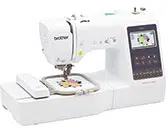Loading ...
Loading ...
Loading ...

Fabric/Thread/Needle Combinations
GETTING READY
27
1
• Needles that can be used with this machine: Home sewing machine needles (size 65/9 - 100/16)
* The larger the number, the larger the needle. As the numbers decrease, the needles get finer.
• Thread that can be used with this machine: 30 - 90 weight
* Never use thread of 20 weight or lower. It may cause machine to malfunction.
* The smaller the number, the heavier the thread. As the numbers increase, the thread gets finer.
• The machine needle and thread that should be used depends on the type and thickness of the fabric. Refer to
the following table when choosing the thread and needle appropriate for the fabric that you wish to sew.
- The combinations shown in the table provide a general guideline. Be sure to sew trial stitches on the actual number of
layers and type of fabric to be used in your project.
- The machine needles are consumables. For safety and best results, we recommend replacing the needle regularly. For
details on when to replace the needle, refer to “Checking the needle” on page 28.
• In principle, use a fine needle and thread with lightweight fabrics, and a larger needle and heavier thread with
heavyweight fabrics.
• Select a stitch appropriate for the fabric, and then adjust the stitch length. When sewing lightweight fabrics,
make the stitch length finer (shorter). When sewing heavyweight fabrics, make the stitch length coarser
(longer). (page 35)
When sewing stretch fabrics, refer to “Sewing stretch fabrics” on page 39.
■ Transparent nylon thread
Use a home sewing machine topstitching needle, regardless of the fabric or thread.
■ Sewing decorative stitch patterns (needles and threads)
When sewing lightweight, medium weight or stretch fabrics, use a ball point needle (gold colored) 90/14. When sewing
heavyweight fabrics, use a home sewing machine needle 90/14.
In addition, #50 to #60 thread should be used.
■ Embroidery needles
Use a 75/11 home sewing machine needle for embroidery.
Fabric/Thread/Needle Combinations
Fabric Type/Application
Thread
Size of needle
Stitch length
mm (inch)
Type Weight
Lightweight
fabrics
Lawn, georgette, challis, organdy,
crepe, chiffon, voile, gauze, tulle,
lining, etc.
Polyester
thread
60 - 90
65/9 - 75/11
Fine stitches
1.8-2.5
(1/16-3/32)
Cotton thread,
Silk thread
50 - 80
Medium weight
fabrics
Broadcloth, taffeta, gabardine,
flannel, seersucker, double gauze,
linen, terry cloth, waffle weave,
sheeting, poplin, cotton twill, satin,
quilting cotton, etc.
Polyester
thread
60 - 90
75/11 - 90/14
Regular stitches
2.0-3.0
(1/16-1/8)
Cotton thread,
Silk thread
50 - 60
Heavyweight
fabrics
Denim (12 ounces or more), canvas,
etc.
Polyester
thread,
Cotton thread
30 100/16
Coarse stitches
2.5-4.0
(3/32-3/16)
Denim (12 ounces or more), canvas,
tweed, corduroy, velour, melton
wool, vinyl-coated fabric, etc.
Polyester
thread
60
90/14 - 100/16
Cotton thread,
Silk thread
30 - 50
Stretch fabrics
(knit fabrics, etc.)
Jersey, tricot, T-shirt fabric, fleece,
interlock, etc.
Polyester thread,
Cotton thread,
Silk thread
50
Ball point needle
75/11 - 90/14
Setting appropriate for
the fabric thickness
For top-stitching
Polyester thread,
Cotton thread
30 90/14 - 100/16
Setting appropriate for
the fabric thickness
50 - 60 75/11 - 90/14
CAUTION
• The appropriate fabric, thread and needle combinations are shown in the preceding table. If the
combination of the fabric, thread and needle is not correct, particularly when sewing heavy fabrics (such
as denim) with thin needles (such as 65/9 to 75/11), the needle may break and cause injury. In addition,
the stitching may be uneven or puckered or there may be skipped stitches.
Loading ...
Loading ...
Loading ...
